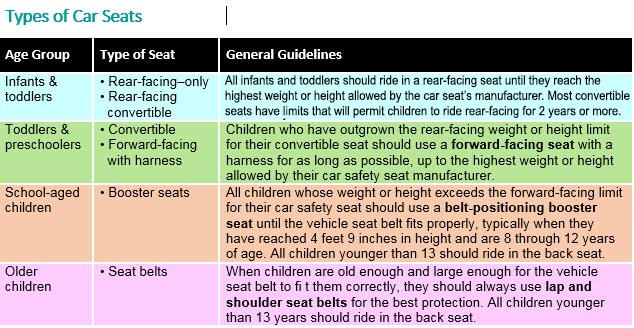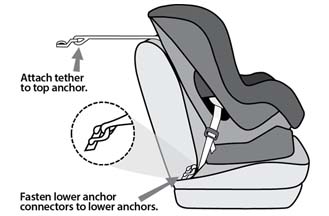Car Seats: Information for Families
One of the most important jobs you have as a parent is keeping your child safe when riding in a vehicle. Each year, thousands of young children are killed or injured in car crashes. Proper use of car seats helps keep children safe. But with so many different seats on the market, many parents find this overwhelming.
The type of seat your child needs depends on several things, including your child's age and size and the type of vehicle you have. Read on for more information from the American Academy of Pediatrics (AAP) about choosing the most appropriate car seat for your child.

Car seats may be installed with either the vehicle's seat belt or LATCH (lower anchors and tethers for children) system.
What is LATCH?
LATCH is an attachment system for car seats. Lower anchors can be used instead of the seat belt to install the seat, and many parents find them easier to use in some cars. The top tether improves safety provided by the seat and is important to use for all forward-facing seats, even those installed using the vehicle seat belt. These systems are equally safe, but in some cases it may be easier to install the car seat using one or the other.
Vehicles with the LATCH system have lower anchors located in the back seat, where the seat cushions meet. Tether anchors are located behind the seat, either on the panel behind the seat (in sedans) or back of the seat, ceiling, or floor (in most minivans, SUVs, and hatchbacks). All car seats have attachments that fasten to these anchors. Nearly all passenger vehicles and all car seats made on or after September 1, 2002, are equipped to use LATCH.
All lower anchors are rated for a maximum weight of 65 pounds (total weight includes car seat and child). Parents should check the car seat manufacturer's recommendations for maximum weight a child can be to use lower anchors. New car seats have the maximum weight printed on their label.
If you install a car seat using your vehicle's seat belt:
You must make sure the seat belt locks to help get a tight fi t. In most newer cars, you can lock the seat belt by pulling it all the way out and then allowing it to retract to keep the seat belt tight around the car seat. Additionally, many car seats have built-in lock-offs to lock the belt without having to lock the seatbelt as well. Refer to the vehicle owner's manual for details about how your seat belt locks.
The safest place to ride for all children younger than 13 years is the back seat. If possible, it may be best to ride in the middle of the back seat. However, it is sometimes difficult to install a car seat tightly in the middle if the vehicle seat is narrow or uneven. Also, most vehicles do not have lower anchors for the middle seating position. It is safest to put the car seat in a position where you can install it tightly with either the lower anchor system or seat belt; in some cases, this may be on either side of the back seat rather than the middle. A child passenger safety technician (CPST) can help you decide which place is best to install your child's car seat in your vehicle.
The AAP recommends that all infants ride rear facing starting with their first ride home from the hospital. All infants and toddlers should ride in a rear-facing seat until they are at least 2 years of age or, preferably, until they reach the highest weight or height allowed by their car seat manufacturer.
Rear-facing–only seats
- Are used for infants up to 22 to 45 pounds, depending on the model.
- Are small, have carrying handles, and sometimes come as part of a stroller system.
- Usually come with a base that can be left in the car. The seat clicks into and out of the base so you don't have to install it each time you use it. Parents can buy more than one base for additional vehicles.
- Should be used only for travel (not sleeping, feeding, or any other use outside the vehicle).
Convertible seats (used rear facing)
- Can be used rear facing and, later, "converted" to forward-facing for older children when they outgrow the weight limit, the length limit, or both for rear facing. This means the seat can be used longer by your child. They are bulkier than infant seats, however, and do not come with carrying handles or separate bases.
- Many have higher limits in rear-facing weight (up to 40–50 pounds) and height than rear-facing–only seats, which make them ideal for bigger babies and toddlers.
- Have a 5-point harness that attaches at the shoulders, at the hips, and between the legs.
- Should be used only for travel (not sleeping, feeding, or any other use outside the vehicle).
3-in-1 seats (used rear facing)
- Can be used rear facing, forward facing, or as a belt-positioning booster. This means the seat may be used longer by your child as your child grows.
- Are often bigger in size, so it is important to check that they fit in the vehicle while rear facing.
- Do not have the convenience of a carrying handle or separate base; however, they may have higher limits in rear-facing weight (up to 40–50 pounds) and height than rear-facing–only seats, which make them ideal for bigger babies and toddlers.
No comments:
Post a Comment